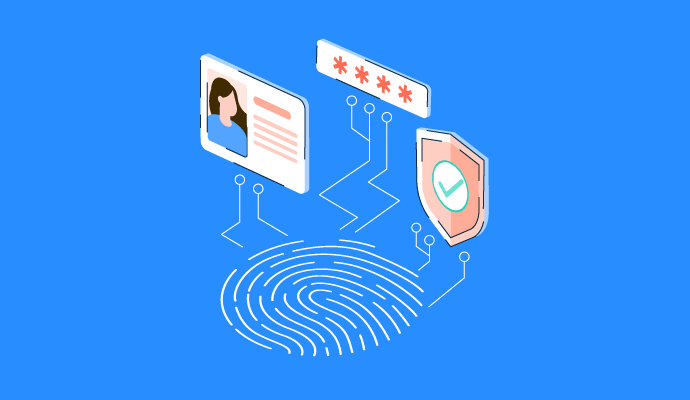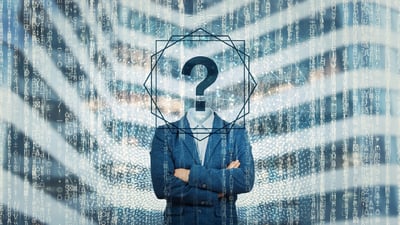

Who are you?
Often, you identify with your name, where you were born, what you've studied, who you work for, and where you live. You’ve got a passport, driver’s license, employee badges, bank account logins, and personal identification numbers. You have a lot of identifiers in the physical world.
But how do you prove who you are in the online world - when you want to order something online, do an online bank transfer, or log in to your company network as you work from home?
That’s where your digital identity comes in.
Digital identity is a collection of attributes that uniquely identify an individual or an entity in the digital world. It includes things like name, email address, IP address, social media profiles, and other credentials.
Digital ID is how you navigate the web, interact with others, and authenticate yourself for a plethora of services - from online banking to team meetings at work. It's your online persona, your virtual thumbprint, and, in essence, it's 'you' in the digital domain.
This digital identity extends beyond individuals to include organizations, devices, software programs, and applications. Just as the computers authenticate an individual's presence online, they also validate the identity and permissions of connected devices and applications in the network, thereby creating a web of trust.
A good digital ID is verified, unique, established with an individual’s consent, protects user privacy, and ensures control over personal data.
Businesses and other organizations use digital IDs to strengthen security and compliance and improve customer experiences. Their IT and security teams get to know precisely who and what systems are accessing their network and what resources are being utilized, all through the digital IDs assigned to individuals, systems, and entities on their network.
Technologies like identity and access management software and decentralized identity solutions help create and manage secure digital IDs today.
Security is the first and foremost reason why digital identity is important. It provides a means to verify the identity of individuals, devices, and entities online. This authentication is essential for secure online interactions and transactions and to prevent unauthorized access, identity theft, and fraud. By establishing a robust digital identity framework, individuals and organizations protect themselves against rising cyber threats.
Related: Learn more about rapidly evolving cyber threats and how they endanger businesses and individuals.
Companies, in particular, use digital IDs to secure data and restrict unauthorized users from accessing business-sensitive information with identity and access management. It reduces the risk of data breaches and the resulting operational, financial, and reputational damages from such attacks.
Privacy control is the second major reason why digital IDs are important. With the ability to manage and authenticate their digital identities, people can choose what data to disclose and to whom. This empowers users to safeguard their data privacy in an era where personal data is highly valuable and susceptible to misuse.
For example, imagine you're using a social media platform, and you want to share some personal information, like your birthday, with your friends, but you don't want this data to be visible to everyone on the platform. With your social media ID and privacy control settings, you can select the specific information you want to share, in this case, your birthday. If you change your mind in the future or if you no longer want to share your birthday, you can easily adjust your privacy settings to restrict or expand access.
Digital IDs also provide convenience with instant virtual authentication. It builds trust between users, organizations, and services. It ensures that users are engaging with legitimate entities, promoting confidence in online interactions that happen, be it for essential amenities like banking, healthcare, government services, and e-commerce or for other purposes like social media networking.
Apart from these reasons, digital IDs reduce paperwork, time, and costs associated with manual procedures for businesses by automating identity verification and authentication processes. This improves operational efficiency and business agility. Digital identity solutions also assist organizations in meeting the regulatory requirements for data protection and privacy, reducing legal risks and potential liabilities.
A wide range of entities possess digital IDs, including:
It’s very easy to get confused with the terms "digital identity," "identity," "users," and "accounts.”
But they have distinct meanings. Here's a brief breakdown of each term to clarify the differences:
For example, a person may have an account on Facebook with a username and password to be a user of the social networking site. Their username, profile picture, friends list, posts, likes, comments, and other activities on Facebook become a part of their digital identity. This Facebook profile is once again part of their identity.
Here are five basic concepts that shape digital identity. Understanding this is necessary to comprehend how digital identities are created, managed, and secured.
Digital identifiers are unique pieces of information that represent the digital identity of individuals, devices, or organizations. They are highly context-specific, meaning digital identifiers can be completely different for various systems and applications.
For instance, the digital identifiers of an individual on an e-commerce platform might be a username or email address, while in the context of an organization they are working in, it could be an employee ID or a specific role-based account.
Digital identifiers are used to:
Digital identity attributes are pieces of information that describe a digital identity. Attributes can be static, like name, date of birth, work experience, and job title, or dynamic, like browsing history, location data, purchasing behavior, and financial data.
Note the distinction between digital identifiers and digital identity attributes is not always clear-cut. For example, a username can be used to both identify a user and to describe them (e.g., a username that includes the user's name or job title).
Authentication is the process of verifying the identity of a user, system, or entity trying to access a particular resource or system. Credentials are used for authentication.
Common authentication factors include:
Credentials are pieces of information that are used to verify digital identity. It vouches for the identity of the digital entity through some form of trust and authentication. The verification can be through a simple password or PIN or more complex, like a digital certificate or two-factor authentication token.
Authorization determines what actions or operations an authenticated user or system is allowed to perform within a given system or resource. Once a user or entity is authenticated, authorization specifies the level of access and permissions granted, defining what the user can or cannot do.
Typically, a person’s identity determines the permissions they have. For instance, your CEO might have access to all data in your organization, while you might have access to only the data you need for your work.
As mentioned earlier, digital identity extends beyond humans to devices and software applications. Here are the three types of digital identity.
Human digital identity is associated with individual people and represents their online presence and interactions. Based on the purpose and platform an individual uses it for, it can be social media identity, email-based identity, government-issued identity, corporate identity, or customer identity. It’s important to remember that the digital identity for personal use is often different from the ID used for business purposes, and enterprises keep it that way to reduce the risks of data breaches.
An individual's digital identity can be interpreted in four ways:
These identities represent non-human entities, like devices, including computers, smartphones, IoT gadgets, applications, and services. The media access control (MAC) address of your computer is an example of device ID.
Today, machine identity management, the process of assigning, monitoring, removing, and organizing digital IDs of devices and applications in an organization’s network, has become a top priority for the IT and security teams for three reasons:
Cloud digital identity is used to securely access cloud-based services and applications. Cloud identities are central to cloud security, given the rising cloud adoption. Today, many IAM solution providers offer cloud-based services for fine-grained access control and visibility for centrally managing enterprise cloud resources.
There are various digital IDs we use every day, each with its own unique purpose and characteristics. Here are some examples:
Despite the immense benefits and opportunities digital IDs offer, it comes with the following risks and challenges.
Digital IDs have inherent privacy and security risks. Your personal identifiable information (PII) that’s online is susceptible to potential data breaches and other cyber attacks.
Digital identity attack vectors include:
For individuals, losing personal data can lead to identity theft, financial and reputational loss, and emotional distress.
For enterprises, even a single account breach can not only result in losing sensitive data but also compromise the whole network. Stolen or lost credentials can be used for account takeover, privilege escalations, ransomware, and other cyberattacks on the enterprise infrastructure. This is why user identities are hot commodities in the dark web, where “privileged accounts” and credentials of enterprise accounts are traded every day.
of hacking-related breaches occur using brute force tactics or lost or stolen credentials.
Source: G2
Digital identity is a complex ecosystem involving a variety of stakeholders and technologies. A person has 90 digital identities. These identities are managed by the government, public and private companies, and other service providers. Different approaches to digital identity by different entities make it difficult to implement and manage digital identity solutions efficiently.
Further, many governments are still exploring and implementing new regulations to protect the personal data privacy and digital identity of their citizens. However, the standard varies across countries. As a result, companies have to meet different regulations like the EU’s General Data Protection Regulation (GDPR), the California Consumer Privacy Act (CCPA), and many more. They are also expected to follow other guidelines, such as the Cybersecurity Framework.
The lack of common standards creates issues for the effectiveness and robustness of an identity system, including problems with interoperability and interconnectivity.
Despite the challenges, the benefits individuals and enterprises get from digital identity are substantial. To maximize these benefits while mitigating risks, it's essential to use a robust digital identity management system with the necessary security features.
Key technologies aiding digital identity management:
Whether you're a consumer or part of a company’s security team, the following tips will help you keep your digital identity safe.
As an individual, all it takes is a few extra precautionary steps to safeguard your online presence from breaches and frauds, and they ain’t tough. So, here are a few simple things for you to get started.
Companies have a much larger number of digital identities to manage, including employee accounts, customer accounts, and machine identities, distributed across a variety of systems and applications, on-premises and in the cloud. This makes it challenging to track and manage all of them effectively. Further, organizations are subject to a variety of industry-specific government regulations.
Here are some specific steps that enterprise IT teams can take:
Technological advancements, challenges to existing centralized digital identity management systems, evolving needs, and changing user expectations are rapidly transforming the digital identity landscape. Here are four key emerging trends that are likely to shape the future of digital identity.
Today, governments around the world are heavily investing in digital identity services and frameworks not only as primary means of establishing and authenticating an individual but also for accurate and efficient delivery of government services. Countries like Austria, Estonia, India, Korea, Portugal, Spain, and Uruguay already have their digital IDs linked to their population registry. Australia, the European Union, and many other countries are in the process of implementing their digital identity system.
By 2024, it’s expected that 5 billion digital IDs will be issued globally by different governments.
Did you know? India has the largest national digital ID system in the world, with more than 1.2 billion enrollments for its Aadhar digital ID.
Government digital IDs provide immense benefits for businesses, too. For example, government-issued digital IDs make it easy to verify a person. Banks, financial institutions, and telecommunication companies speed up the know-your-customer (KYC) process using government-issued digital IDs. Organizations use it to verify customers and employees.
Biometric authentication methods, such as fingerprint, voice, and facial recognition, are becoming increasingly sophisticated and secure. It’s more attractive than the traditional way of keying alphanumeric passwords. They are effective against brute force attacks and phishing and provide user convenience as they don’t have to remember many passwords.
The use of distributed ledger technology (DLT) and blockchain to create decentralized digital identity systems has been on the rise to address the problems faced by traditional, centralized, and federated identity systems.
A decentralized identity system gives individuals more control over their own data and makes it easier to share their identity with others without having to go through a central authority. Companies, especially banking and financial services, are eager to adopt the technology to prevent fraud and improve customer authentication and regulatory compliance. It’s estimated that the global decentralized identity market will surpass $100 billion by 2030.
A parallel trend on the rise is the move towards sovereign self-identity (SSI) systems. SSI allows individuals to create their own digital identities and share them with others without having to go through a central authority, supported by decentralized identity solutions.
* These are the five leading decentralized identity solutions from G2's Winter 2024 Grid® Report.

The world is gradually moving toward a time when individuals’ online identities match their real-life identities and provide a global and accurate view of who they are, what they do, and how they see themselves.
As digital identity solutions continue to develop and mature, we can expect to see even more innovative and secure ways to manage our digital identities. This will enable us to reap the full benefits of digital identity, such as the ability to access services more easily and securely and to share our data with others in a controlled and privacy-preserving way.
Interested to learn more about preventing unauthorized access? Read about federated authentication and how it improves security.

Explore decentralized identity solutions that help show who you are online safely.
Soundarya Jayaraman is a Content Marketing Specialist at G2, focusing on cybersecurity. Formerly a reporter, Soundarya now covers the evolving cybersecurity landscape, how it affects businesses and individuals, and how technology can help. You can find her extensive writings on cloud security and zero-day attacks. When not writing, you can find her painting or reading.

Explore decentralized identity solutions that help show who you are online safely.
There are things you don’t mind sharing, like your favorite leather jacket or your fries with...
 by Mara Calvello
by Mara Calvello
The software procurement process has come a long way since software was mailed on CDs.
 by Indus Khaitan
by Indus Khaitan
Applications and databases are crucial for business operations, and so is their security.
 by Sagar Joshi
by Sagar Joshi
There are things you don’t mind sharing, like your favorite leather jacket or your fries with...
 by Mara Calvello
by Mara Calvello
The software procurement process has come a long way since software was mailed on CDs.
 by Indus Khaitan
by Indus Khaitan
Never miss a post.
Subscribe to keep your fingers on the tech pulse.



